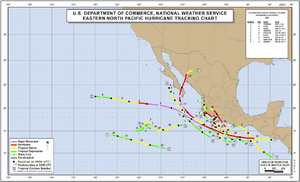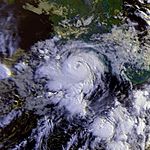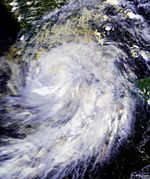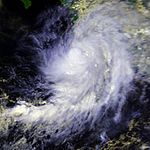Quick facts for kids
1996 Pacific hurricane season
 |
| Season summary map |
| First storm formed |
May 13, 1996 |
| Last storm dissipated |
November 11, 1996 |
| Strongest storm |
Douglas – 946 mbar (hPa) (27.95 inHg), 130 mph (215 km/h) (1-minute sustained) |
| Total depressions |
14 |
| Total storms |
9 |
| Hurricanes |
5 |
| Major hurricanes (Cat. 3+) |
2 |
| Total fatalities |
27-49 |
| Total damage |
Unknown |
Pacific hurricane seasons
1994, 1995, 1996, 1997, 1998 |
The 1996 Pacific hurricane season was a time when tropical cyclones formed in the Pacific Ocean. It was one of the quietest seasons ever recorded, with only a few storms. The season officially started on May 15, 1996, in the eastern Pacific. It began on June 1, 1996, in the central Pacific. The season ended on November 30, 1996. These dates are when most tropical cyclones usually form in this part of the world.
Even though it was a quiet season, some storms caused problems. Twelve tropical cyclones formed this year. Five of these storms hit land directly. Two other storms affected land areas nearby. Early in the season, three storms hit Mexico within just ten days. The first storm of the season even formed before the official start date. Hurricane Douglas was the strongest storm. It reached Category 4 on the Saffir–Simpson Hurricane Scale, which means it had very strong winds. Interestingly, Hurricane Douglas actually started as a storm in the Atlantic Ocean.
Timeline of the 1996 Pacific Hurricane Season
Notable Storms of 1996
Hurricane Alma: First to Hit Mexico
| Category 2 hurricane (SSHS) |
|
|
| Duration |
June 20 – June 27 |
| Intensity |
105 mph (165 km/h) (1-min), 969 mbar (hPa) |
Hurricane Alma was the first of three storms to affect the Pacific coast of Mexico in a short time. Alma caused the deaths of at least three people. There were also unconfirmed reports that 17 more people died from floods in Puebla. These floods were caused by heavy rains from Alma. The hurricane knocked down trees and caused power outages in many areas. Roads were also flooded and covered with debris.
Hurricane Boris: Causing Floods in Mexico
| Category 1 hurricane (SSHS) |
|
|
| Duration |
June 27 – July 1 |
| Intensity |
90 mph (150 km/h) (1-min), 979 mbar (hPa) |
Hurricane Boris was the second storm in a row to get close to Mexico. It made landfall on June 29, between Acapulco and Lazaro Cardenas. Boris caused the deaths of ten people. A big flood from Boris on the San Jeronimo River left thousands of people without homes.
Tropical Storm Cristina: Missing Fishermen
| Tropical storm (SSHS) |
|
|
| Duration |
July 1 – July 3 |
| Intensity |
70 mph (110 km/h) (1-min), 991 mbar (hPa) |
Tropical Storm Cristina was the third storm to come near Mexico within ten days. It caused the death of one fisherman whose boat was caught at sea off Oaxaca. At least 11 other fishing boats and 22 people went missing. Their whereabouts are still unknown.
Hurricane Douglas: The Strongest Storm
| Category 4 hurricane (SSHS) |
|
|
| Duration |
July 24 – August 6 |
| Intensity |
130 mph (215 km/h) (1-min), 946 mbar (hPa) |
Hurricane Douglas was actually a continuation of Atlantic Hurricane Cesar. Cesar had crossed over Central America and then entered the Pacific Ocean. When it entered the Pacific on July 29, it was still a tropical storm. It quickly became a hurricane again.
Douglas grew stronger over the next two days. It moved parallel to the coast of Mexico. On August 1, it reached its strongest point. Its winds were about 132 miles per hour (212 km/h). Its central pressure was 946 millibars. This made it the strongest hurricane of the 1996 season. Douglas started to weaken on August 2 as it moved into cooler waters. It officially ended on August 6. However, like many Pacific hurricanes, its leftover circulation could still be tracked for several days.
Hurricane Fausto: Crossing Land Twice
| Category 3 hurricane (SSHS) |
|
|
| Duration |
September 10 – September 14 |
| Intensity |
120 mph (195 km/h) (1-min), 955 mbar (hPa) |
The storm that became Fausto was first seen over Venezuela around August 31. It might have been linked to the same weather system that created Hurricane Fran. By September 4, this system had moved across Central America into the Pacific. It slowly became more organized and was named Tropical Storm Fausto on September 10.
Fausto quickly became a hurricane on September 12. It reached its peak strength with winds of about 121 miles per hour (195 km/h). Its lowest central pressure was 955 millibars. The hurricane then weakened as it met a weather system that caused strong winds high up. This same weather system also turned Fausto north on September 13. It made landfall as a weak hurricane in Baja California that day. On September 14, the storm moved northeast across the Gulf of California. It then ended over the Sierra Madre mountains after hitting land a second time as a hurricane. Its remnants briefly caused some activity over northern Mexico and Texas.
The damage in Mexico from Fausto was not too severe. There was only one death, caused by a fallen power line.
Hurricane Hernan: Damaging Infrastructure
| Category 1 hurricane (SSHS) |
|
|
| Duration |
September 30 – October 4 |
| Intensity |
85 mph (140 km/h) (1-min), 980 mbar (hPa) |
Hurricane Hernan made landfall in a part of Mexico where not many people live. It washed out roads and knocked down power lines and telephone poles. About 100 people were injured, but thankfully, no one died.
|
Tropical cyclones of the 1996 Pacific hurricane season
|
|
|
|















